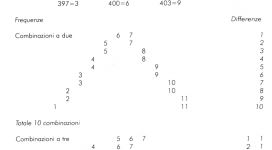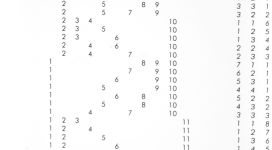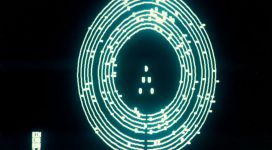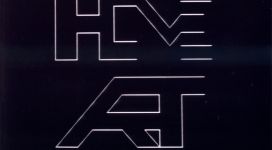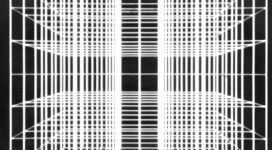| PIETRO GROSSI close up | ||
| PiGro: interdisciplinarietà e computer | ||
| curated by Lucilla Saccà | ||
| 6 – 20 december 2013 |
As part of Close Up, Gallery Il Ponte presents in their lounge area, an exhibition dedicated to Maestro Pietro Grossi, a great renovator of contemporary music, as well as a composer, programmer, teacher, and pioneer of experimental and computer music. The exhibition is held in conjunction with the Department SAGAS, Biblioteca Umanistica and the University of Florence, and with Pietro Grossi: From the Cello to Computer Art and the Recital of the Musical Production of the Maestro. Pietro Grossi’s work had led the research of music from the new Florentine avant-garde in the sixties and seventies into an international debate and had proposed experiments of complete innovation, which later became a practice still currently used.
The exhibition in the gallery highlights the close link that Grossi observed since the early 60s between art and music. (He was so involved that in 1962 Musica e Segno, a show of his, and others’, so-called “musical charts” was curated by Giuseppe Chiari and Sylvano Bussotti.) As written in Marcatre in 1965, presenting the affinity between music and art. “…reduction of means, in concentration of research values with fewer means possible. I see that paintings use few colors; we use few sounds and try to get all the values that they can give.” In recent years, the relationship with visual art is evident through some of his scores and graphics of programmed music, which is also influenced by the “finding of artistic-cultural common grounds … between a certain kind of visual expression (neo-concrete art, programmed art, optical art, etc.), the experiences of concrete poetry and electronic music” as underlined in 1967 by Lara-Vinca Masini. But since the mid-80s, Pietro Grossi addressed the aesthetic research that matured in the music field and in the boundaries of art, with the help of Marcella Chelotti, his life partner and an artist herself. He is dedicated to what he calls HomeArt, domestic graphic art, “created by and for themselves, unexpectedly ephemeral, beyond the sphere of the judgment of others,” using computer software he programmed. Multiple “unique copies” of real Homebook and Alphabets are reconstructed by the creation of computerized designs that reinvent every single letter graphically.
In partnership with Dipartimento SAGAS e Biblioteca Umanistica, Università di Firenze.
Pietro Grossi was born in Venice in 1917. After graduating with a diploma in cello from the Conservatory of Bologna in 1936, he won the competition for the position of principal cellist in the orchestra of the Maggio Musicale Fiorentino, where he stayed until 1966. In 1941 he received a diploma in composition and wrote his first composition for orchestra and chamber music. In 1956 he won the competition for the Department Chair in cello at the Music Conservatory in Florence, a post he held for forty years. Between 1960 and 1970, Grossi dedicated himself to the production of artificial sound. In 1961 (up until 1967), he created the Florentine Association in Contemporary Musical Life, with the involvement of Giuliano Toraldo di Francia, Marcella Chelotti (his life partner) and Giuseppe Chiari, with whom he established a deep friendship and respect for. Each year the Association hosts electronic music concerts of whom are invited Cage, Stockhausen, Metzeger, Berberian, and active members of Fluxus, where music and art often merge. In 1962 he had his first contact with an electronic computer, and at the exhibition Musica e Segno, curated by Chiari and Bussotti at the Galleria Numero in Roma, the musical scores were displayed as stand-alone works of art and/or musical sheets.In 1963, he founded Studio of Musical Phonology of Florence S 2F M one of the first in the world, and in 1965 he established the first Department Chair in Italy in electronic music at the Conservatory of Florence (in 1984 there will be computer music). He had his first experience in computer music in 1967 by playing with a giant computer and punch cards at the Olivetti General Electric in Pregnana Milanese and encouraged the establishment of the Division of Musical Informatics CNUCE (now CNR) in Pisa. The following year he organized for the XXXI Maggio Musicale in Florence the first International Conference of Experimental Electronic Music. In 1970 he became deeply involved in telematic music, probably the first streaming audio in history, between Rimini and Pisa, and presented programs in computer music at the Festival of Contemporary Music in Venice. In 1984 at the Conservatory of Florence he taught the first course in Computer Music. Since 1986, he extended his experiments to images, in particular to computer graphics, writing programs with specific auto-decisions, and developing the concept of HomeArt, presented for the first time in the exhibition New Atlantis: the continent of electronic music.
“…This is, or could be HomeArt: mental relaxation together with the moment of commitment to the creation of environments for work/study/rest by means of sound, sign, color…” At this stage of work, the Maestro produced images rather than sounds claiming the considerable autonomy that the personal computer can offer to anyone who wants to express their individuality in art, music, graphics and other disciplines. The graphic creations are made with the program Archimedes that allows for good quality in color and movement. Since then, he made many programs from HomeArt resulting in visual realizations often presented in the form of photographs, displayed in exhibitions from Venice to Florence, Rome, Milan, Bologna. The artist also produced electronically a number of unique books, Homebook, promoting a sort of personal publishing, “ineditoria”, theorizing that man can consume himself in the aesthetic. The word becomes a work of art. “The computer frees us from the genius of others and increases ours.”
The first edition of HomeBook (1991) was publicly presented at the Pecci Museum in 1991. 100 copies were printed, each one different from the other. “For the first time ever, a presentation of a publication graphically reinvented by the computer, programmed by me for each copy. A section of these unique books, that is HomeArt, also varies in content. For the program on 21 September 1991, I made on the personal computer, in a phase of test prints, a hundred copies of the publication, one hundred unique ones.” It is a custom home publisher, made without loose sheets of perforated paper for the printer, fasten with double bars of plastic and covered with clear acetate. Unique books are electronic products (with dot matrix printers) created with programs by Grossi. His last Homebook was dedicated to Futurism 11 March 1913 The Art of Noises, Luigi Russolo. Sergio Maltagliati continued this project in 2012 creating a software autom@tedVisuaL1.0, that continued from the original programs of Grossi’s HomeArt, which generated 45 unique graphics.
Since the mid-nineties, the emergence of the Internet has created the opportunity to see many things that had been anticipated. In collaboration with Sergio Maltagliati, composer and programmer dedicated to digital art and computer music, in 1997 the conception and realization of collective multimedia work was put online on netOper@, a work subjected to continuous transformation thanks to the contributions from the many (net)artists involved. Grossi materialized his research from an idea into this work as the result of collaboration, its community. The first performance takes place in his home studio in Florence. However, NeXtOper@ remains unfinished, a project to integrate new media, such as mobile phone and GPS.
He died in Florence in 2002.






